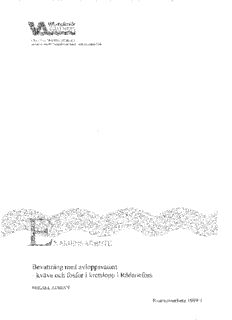
Bevattning med avloppsvatten PDF
Preview Bevattning med avloppsvatten
CHALMERS Bevattning med avloppsvatten - kvave och fosfor i kretslopp i Radanefors MIKAEL ADRIAN Examensarbete 1999: 1 CHALMERS TEKNISKA HOGSKOLA Institutionen tor vattenforsorjnings-och avloppsteknik 412 96 GOTEBORG Tel 031-772 10 00 Nyckelord bevattning kvave fosfor avloppssystem kretslopp lagringsdamm avloppsvatten XAMENSARBETE Bevattning med avloppsvatten - kvave och fosfor i kretslopp i Radanefors MIKAEL ADRIAN Examensarbete 1999: 1 Detta examensarbete har utforts vid institutionen for vattenforsorjnings och avloppsteknik vid Chalmers Tekniska Hogskola. Det praktiska arbetet har delvis utforts i Radanefors i Fargelanda kommun. Examensarbetet utfordes efter en intresseanmalan fran Fargelanda kommun om samarbete med Mistraprogrammet Urban Water. Kontakten togs med programmets chef Per-Arne Malmqvist som lamnade forslaget till Erik Karrman som tog kontakt med undertecknad. Kommunen ville att driften av kretsloppsanlaggningen i Radanefors skulle undersokas. Vid ett mote mellan alia inblandade parter i Radanefors i juni 1999 drogs narmare riktlinjer for arbetet upp. Jag vill tacka min handledare Erik Karrman, min examinator Gilbert Svensson och Per Arne Malmqvist pa Mistraprogrammet Urban Water for att de har stallt upp och kommit med stod, synpunkter och nya infallsvinklar pa mitt arbete. Dessutom vill jag tacka Jan Ohman, drivkraften bakom projektet i Radanefors, med familj for den stora gastfrihet och hjalpsamhet de har visat. Ett stort tack ocksa till Evy Axen, Lars-Olof Sorman och Bengt-Olov Sjostrom for hjalp med analyser och analysmetoder samt provtagningar, utrustning och installationer vilket har tagit mycket dyrbar tid i ansprak. Sist men inte minst ett stort tack till Fargelanda kommun som tillhandaholl analysutrustning och som bidrog med ekonomiskt stod for inkop av reagens till kemiska analyser. Goteborg i november 1999 Mikael Adrian Detta examensarbete studerar en kretsloppslosning for bevattning med avloppsvatten i Radanefors i Dalsland. Syftet med anlaggningen iir att atervinna niiringsiimnena kvave och fosfor i avloppsvatten till jordbruket via bevattning. Anlaggningen bestar av ett reningsverk utan kemisk rening och ett dammsystem for biologisk rening och lagring av avloppsvattnet. Huvudsyftet med examensarbetet var att utviirdera bevattning med lagrat avloppsvatten som kretsloppsteknik for niiringsiimnen. Detta gjordes genom att beskriva-flo den av fosfor och kvave genom systemet for att kunna svara pa om niiringen behalls i lost i vatten och diirmed nyttiggors i j ordbruket. En slutsats iir att vattnets skiktning innebiir att yt- och bottenvattnet har olika egenskaper (pa grund av syrefattig botten) och att det diirfor gar att anviinda det till olika iindamal. De olika anviindningsomradena kan vara bevattning av grodor med niiringsrikt bottenvatten men det kan ocksa vara bevattning med ett rent ytvatten vid enb art vattenbehov. Dessutom visade det sig att en for lang lagringstid av vattnet inte iir bra. Haltema av kvave minskar med okad lagringstid. En trolig forklaring iir att kvave avgar genom denitrifikation under lagringen. Av en fosforhaltema sjunker beroende pa sedimentation. Baserat pa det matunderlag som finns tillgiingligt dras ocksa slutsatsen att kretsloppet for tillfallet inte fungerar lika bra som tiinkt. En stor del av niiringen forsvinner ut ur systemet innan vattnet tillfors akermarken. Den niiring som finns i bevattningsvattnet racker diirfor inte till att goda speciellt stora arealer for odling av nagon groda. Dock har systemet potential att gora detta. De viktigaste atgardema for att oka effektiviteten hos kretsloppet och diirmed oka niiringsinnehallet i vattnet ar att forkorta lagringstiden i dammama, att minska niiringsminskningen i reningsverket samt att minska inlackaget tillledningsnatet. Med nuvarande forutsattningar (u tan foreslagna foriindringar) iir det fordelaktigt att endast anviinda bottenvattnet till bevattning eftersom en dominerande andel av niiringsinnehallet finns dar. II This graduate work studies a recycle solution for irrigation with sewage in Radanefors in Dalsland. The purpose with the system is to recycle nutritious sewage water containing nitrogen and phosphorus to agriculture through irrigation. The system consists of a biological sewage treatment plant without chemical treatment and ponds for biological treatment and storage of sewage. The main purpose with this work was to evaluate irrigation with stored sewage as a recycling technique for nutrients. This was done by studying the flow of nitrogen and phosphorus through the system in order to answer if nutrients are kept dissolved in water and thus can benefit agriculture. One conclusion is that the stratification of water in the ponds gives two types of water with different properties, a surface- and a deep water. This two waters can be used for different purposes. These are irrigation of crops with nutrient rich deep water and irrigation with clean surface water if only water is needed. Further, the study shows that a long storage time of sewage is unfavourable. The content of nitrogen decreases when storage time increases. One probable explanation is that nitrogen is lost to the atmosphere through denitrification. Also the content of phosphorus is reduced due to sedimentation. Another conclusion from this study is that the recycling system does not work as planned at the moment. Large amount of nutrients leaves the system before the water supplies the field. The content of nutrients in the sewage is thus not enough to fertilise particularly large areas of any crop. However the system have potential to do so. The most important measures to increase the efficiency of the recycling system and thus increase the content of nutrients in the ponds is to shorten the storage time, to reduce the loss of nutrients in the treatment plant and to reduce the inleakage to the sewer system. With current conditions (without suggested changes) it is favourable to use only deep water for irrigation since a dominant proportion of nutrients in the ponds can be found there. Ill
Description: